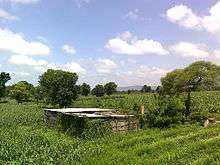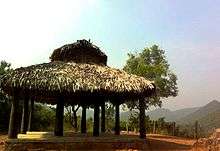Hut

A hut is a primitive dwelling, which may be constructed of various local materials. Huts are a type of vernacular architecture because they are built of readily available materials such as wood, snow, ice, stone, grass, palm leaves, branches, hides, fabric, and/or mud using techniques passed down through the generations.
A hut is a shape of a lower quality than a house (durable, well built dwelling) but higher quality than a shelter (place of refuge or safety) such as a tent and is used as temporary or seasonal shelter or in primitive societies as a permanent dwelling.[1]
Huts exist in practically all nomadic cultures. Some huts are transportable and can stand most conditions of weather.
Word
The term is often employed by people who consider non-western style homes in tropical and sub-tropical areas to be crude or primitive, but often the designs are based on traditions of local craftsmanship using sophisticated architectural techniques. The designs in tropical and sub-tropical areas favour high airflow configurations built from non-conducting materials, which allow heat dissipation. The term house or home is considered by some to be more appropriate.
In the Western world the word hut is often used for a wooden shed.
The term has also been adopted by climbers and backpackers to refer to a more solid and permanent structure offering refuge. These vary from simple bothies – which are little more than very basic shelters – to mountain huts that are far more luxurious and can even include facilities such as restaurants.
The word comes from the 1650s, from French hutte "cottage" (16c.), from Middle High German hütte "cottage, hut," probably from Proto-Germanic *hudjon-, related to the root of Old English hydan "to hide," from PIE *keudh-, from root (s)keu- (see hide (n.1)). Apparently first in English as a military word. Old Saxon hutta, Danish hytte, Swedish hytta, Frisian and Middle Dutch hutte, Dutch hut are from High German."[2] related to hide, a covering.
Modern use


Huts are used by shepherds when moving livestock between seasonal grazing areas such as mountainous and lowland pastures (transhumance).
They are also commonly used by backpackers and other travelers in rural areas.
Some displaced populations of people use huts throughout the world during a diaspora. For example, temporary collectors in the wilderness agricultural workers at plantations in the Amazon jungle.
Huts have been built for purposes other than as a dwelling such as storage, workshops, and teaching.
Types
- Balok – A Siberian wilderness hut made of logs, usually communal, used by hunters, fishermen and travelers in the more distant parts of Siberia. Some baloks are mobile and mounted on sleds.
- Barabara – An earth sheltered winter home of the Aleut people
- Barracks – an old term for a temporary hut,[1] now more used as a term for military housing and a unique hay storage structure called a hay barrack.
- Bothy – Originally a one-room hut for men farm workers in the United Kingdom, now a mountain hut for overnight hikers.
- Burdei or bordei – a dugout or pit-house with a sod roof in Ukraine, Canada
- Cabana – an open shelter
- Chozo also spelled chozo – Spanish for hut, term also used in Mexico.
- Clochán – A dry stone hut in Ireland
- Earth lodge – Native American dwelling
- HORSA hut - A prefabricated school building built to cope with additional demand from the Education Act 1944
- Hytte – A cabin or hut in Norway
- Igloo – A hut made of pieces of hard snow or ice
- Kolba – Afghanistan
- Laing hut - prefabricated lightweight timber wall sections bolted together, externally clad with plasterboard and felt. Designed 1940 for barrack accommodation[3]
- Lodge is a general term for a hut or cabin such as a log cabin or cottage. Lodge is used to refer to a tipi, sweat lodge, and hunting, fishing, skiing, and safari lodge.
- Mitato – A small, dry stone hut in Greece
- Orri – A French dry stone and sod hut
- Pratten hut - A prefabricated building generally used in schools for classrooms in the UK after World War 2.
- Rondavel – Central and South Africa
- Sheiling – Originally a temporary shelter or hut for shepherds, now may be a stone building. Common in Scotland.
- Sod house – A pioneer house type on the American Plains where wood was scarce.
- Tipi – Central North America tent
- Tule hut – Coastal North America, West Coast, Northern California
- Oca – Brazil
- Quinzhee – A shelter made in a pile of snow
- Yurt – Central and North Asia
Construction
.jpg)
Many huts are designed to be relatively quick and inexpensive to build. Construction often does not require specialized tools or knowledge.
Marketing usage
Hut is used to name commercial stores, companies, and concepts. The name implies a small, casual venue, often with a fun and friendly atmosphere. Examples include Pizza Hut and Sunglass Hut. Kiosks may be constructed to look like huts and are often found at parks, malls, beaches, or other public places, selling a variety of inexpensive food or goods. Luxury hotels in tropical areas where guests are assigned to occupy their own freestanding structure sometimes call the structure a "hut", though such huts typically bear little more than superficial resemblance to the traditional concept of a hut.
See also
| Wikimedia Commons has media related to Huts. |
- Architecture of Africa
- Backcountry hut – huts that serve overnight hiking and trekking needs
- Bothy – simple shelter
- Cabane en pierre sèche (French dry stone huts)
- Lean-to – a type of shelter
- Log cabin – small house built from logs
- Nissen hut – a prefabricated steel structure made from a semicircle of corrugated steel invented 1st quarter 20th century.
- Jamesway hut – a variation of a Nissen hut
- Romney hut – a variation of a Nissen hut
- Quonset hut – a type of Nissen hut of lightweight prefabricated structure of corrugated steel having a semicircular cross section
- Palloza – Spanish type of roundhouse
- The Primitive Hut – Concept in architectural theory
- Roundhouse (dwelling) – a circular hut or house typically with a conical roof
- Vernacular architecture – traditional architecture in a particular area
- Wilderness hut – rent-free, open dwelling place for temporary accommodation
- Yurt
References
| Look up hut in Wiktionary, the free dictionary. |
- 1 2 Oxford English Dictionary Second Edition on CD-ROM (v. 4.0) © Oxford University Press 2009
- ↑ "Online Etymology Dictionary". etymonline.com. Retrieved 2015-03-15.
- ↑ "Warwickshire County Council Museum: Laing hut". Retrieved 27 January 2016.
